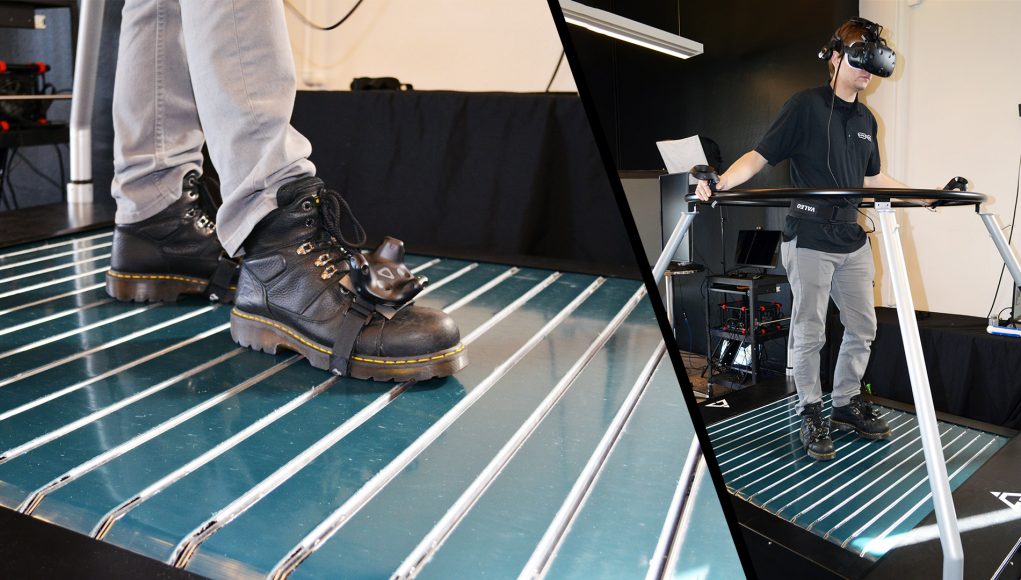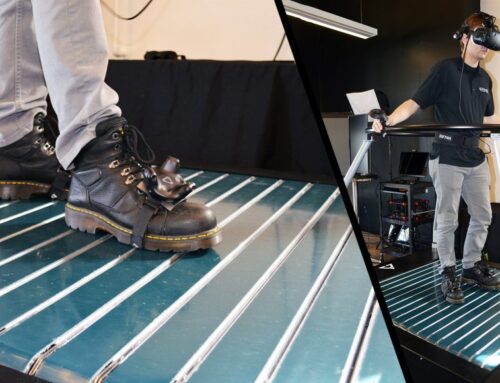Infinadeck is an active omni-directional VR treadmill that lets you walk in any direction. Compared to others, which generally rely on low friction surfaces to emulate the act of walking, Infinadeck’s design actually has a tread that moves beneath you, leading to a much more natural gait. Having stepped on the latest Infinadeck prototype, the VR treadmill is making strides toward a truly compelling solution for artificial locomotion in VR.
I’ve had a chance to try out the Infinadeck at several key milestones during its development, as far back as 2014 when the device made its debut at the very first SVVR Conference & Expo. Even back then, it was clear that the fundamental design—a large ‘tank track’ where each tread itself consists of a mini-treadmill running perpendicular to the direction of the track—had potential. But that 2014 version was manually controlled, with no mechanism at the time to sense the movement of the user and then counteract that movement with opposite vectors from the treadmill.
From that point, the company began investigating tracking mechanisms, and we got our first look in early 2016 where a waist-harness, connected by a pole to a device above, would physically detect the movement of the user, and then use their direction to calculate the counteractive movements. It worked relatively well for walking in straight lines, but the lack of precision and the latency in movement detection made it challenging to walk confidently once you put on the headset and lost some of your proprioception.

With the latest Infinadeck prototype, which I saw recently at SVVR’s Silicon Valley HQ, the company has moved from physical motion detection to using a Vive Tracker mounted on the waist to precisely sense the location of the user with very low latency. Along with Vive Trackers placed on the feet (not currently used for calculating the VR treadmills movements, but used to show the user where their feet are), the feeling of walking has been significantly improved, even when wearing a VR headset.
Thanks to the fact that the surface is physically moving below you, your walking gait is very natural. Especially when heading directly along the ‘track’ direction, or directly along the ‘tread’ direction, it feels almost identical to walking on a normal treadmill. When you are moving diagonally, the movements of both the ‘track’ and the ‘tread’ need to be combined to create a vector of diagonal movement; that can still feel a little bit funky, as if the vector sometimes slightly fluctuates away from the ideal direction. But as with the rest of it, after a few minutes of walking around I began to feel quite comfortable walking in any direction.
Wearing an HTC Vive (made wireless with TPCAST), I strolled around a simple demo scene that worked well enough, though unfortunately they haven’t spent much time precisely matching your actual stride distance to the distance that you move in the virtual world (instead it felt like my virtual movement speed was based on the speed of the treadmill), let alone your height in the experience. So while I could feel the quite natural gait afforded by the treadmill, it’ll take a more polished demo before I can really assess the impact that the system has on immersion.

Other VR treadmills that I’ve tried—like the Virtuix Omni and Cyberith Virtualizer—rely on your feet sliding along low friction surfaces in order to simulate movement. While I’ve found the Omni pretty good for walking and running in a particular direction, turning is where things start to feel especially slippery and unnatural. That’s because walking or running along a curved path is in every way reliant on the friction between your feet and the ground.
Turning on the Infinadeck feels much more natural, since you have the friction of the surface below you to turn yourself as your really would in a normal turning gait. Stopping also benefits a lot from this, and it’s now far more responsive than I’ve seen in previous iterations of the VR treadmill, as the platform gently slides you back to the center and stops you there.




